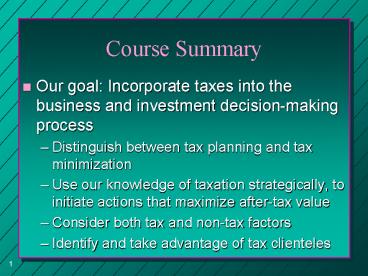Course Summary - PowerPoint PPT Presentation
Title:
Course Summary
Description:
... subject to double taxation, but potential for significant nontax savings ... Tax and nontax factors affecting choice between asset versus stock acquisition, ... – PowerPoint PPT presentation
Number of Views:32
Avg rating:3.0/5.0
Title: Course Summary
1
Course Summary
- Our goal Incorporate taxes into the business and
investment decision-making process - Distinguish between tax planning and tax
minimization - Use our knowledge of taxation strategically, to
initiate actions that maximize after-tax value - Consider both tax and non-tax factors
- Identify and take advantage of tax clienteles
2
Impact of Taxation on After-Tax Value
- Differences in tax treatment across different
types of investment and financing decisions, and
across different taxpayers, will influence both - Before-tax return on investment
- Example Tax exempt municipal bonds typically
pay lower before-tax rates of return than taxable
corporate bonds - After-tax return on investment
- Example Long-term capital gains of individual
taxpayers are often taxed at lower tax rates than
similar gains earned by corporate taxpayers
3
Effective Tax Planning
- 3 Key Considerations
- All parties Effective tax planning requires the
planner to consider the tax implications of a
proposed transaction to all parties to the
transaction - Example In negotiating an asset purchase, the
buyer should consider the tax implications of the
transaction to the seller, as well as the manner
in which the purchase will be financed
4
Effective Tax Planning continued
- All costs Effective tax planning recognizes that
taxes represent only one of many business costs.
In the planning process all costs must be
considered, including the costly restructuring of
the business necessary to implement some tax
plans - Example Operating a business as a C corporation
imposes double-taxation, yet provides substantial
reduction in nontax costs via access to capital
markets, liability protection,etc.
5
Effective Tax Planning continued
- All taxes Effective tax planning requires the
planner, in making investment and financing
decisions, to consider not only explicit taxes
(tax dollars paid to tax authorities) but also
implicit taxes (taxes paid via lower before-tax
rates of return on tax-favored investments) - Total tax Explicit tax Implicit tax
- To receive tax favors, you typically either
- pay implicit taxes or
- pay more non-tax costs
- Either way, the before-tax rate of return is lower
6
Other Takeaways
- 3 broad categories of tax planning
- Converting income from one type to another
- Ordinary versus capital gain
- US-source versus foreign source
- Shifting income from one time period to another
- Shifting from a high-tax rate to a low-tax rate
year - Shifting income from one pocket to another
- Use of a foreign versus a domestic subsidiary
7
Other Takeaways continued
- Organizational form decision
- Corporations subject to double taxation, but
potential for significant nontax savings - Compensation planning
- Saving for retirement via qualified plans
provides substantial benefits for both employee
and employer - Value of tax knowledge in planning for the
exercise of stock options
8
Other Takeaways continued
- Corporate tax planning
- Section 351
- Dividends-received deduction
- Mergers and acquisitions
- Tax and nontax factors affecting choice between
asset versus stock acquisition, taxable versus
nontaxable acquisition
9
Other Takeaways continued
- Differences between GAAP and tax
- Effective tax rate versus marginal tax rate
- GAAP versus tax basis
- GAAP versus tax goodwill































